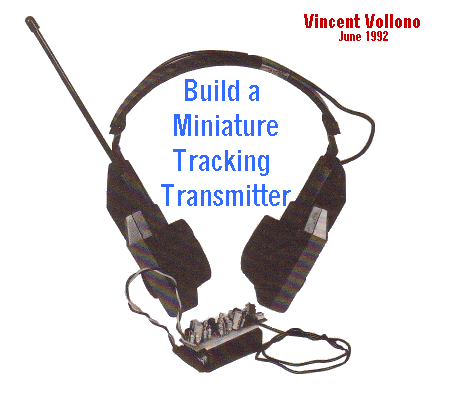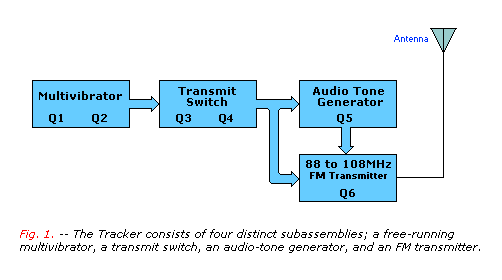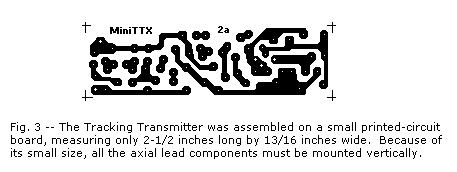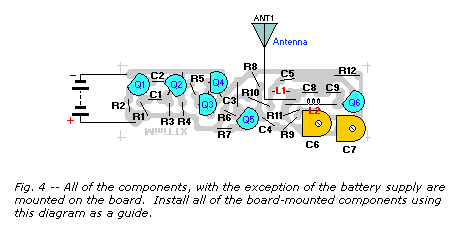
"This little circuit can help you to find your car in a packed parking lot; locate a child who has disappeared in a crowd; or reunite you with a dog that has escaped the confines and safety of your yard."
by Tony van Roon
When we need to locate an object, the first sense that we use is sight. Well, with the Tracking Transmitter described in this article, you can also use your hearing . The Tracking transmitter outputs a series of short, tone-modulated pulses that can be picked up on almost any FM receiver, as a recognizable beep. Using a FM receiver (either mobile or portable), one can scout areas where you might expect the object to be located.
When the transmitted signal is detected, simply varying the position of the receiver will cause the received signal strength to increase of decrease, enabling you to determine the general direction of the signal. By continuing to scan the area, you should soon be able to pinpoint the location of the object.
Description:
The Tracking Transmitter (see the block diagram in Fig. 1.) is a fairly simple circuit consisting of four distinct sub-assemblies; a free-running multivibrator, a transmit switch, and audio-tone generator, and an FM transmitter.
The multivibrator is used to control the transmit switch, 3which turns both the audio generator and the transmitter on and off at a given rate. That helps to reduce power consumption to a bare minimum. The output of the audio generators is fed to the FM transmitter, which puts out a periodic beep in the 88- to 108MHz range that can be detected using an ordinary FM receiver.
A schematic diagram of the Tracking Transmitter is shown in Fig. 2. The multivibrator is comprised of components Q1, Q2, C1, C2, and R1 through R4. The values of R2 and R3 have been chosen to produce a pulse width of 300 milliseconds with a pulse separation of 1500 milliseconds. The output of the multivibrator, which is taken from the collector of Q2, is coupled through R5 to the base of Q3. The output of Q3, taken at its emitter, is used to drive Q4. Together those two transistors (Q3 and Q4) form the transmit switch.
When the output of the multivibrator swings positive, Q3 turns on, which in turn turns Q4 on. With Q4 on, the emitter of Q6 is pulled to ground, causing it to conduct. With Q6 conduct98ng, any signal applied to its base is transferred to the antenna, which is connected to the junction formed by C8 and C9. Components Q5, R6, R7, R8, and C3 make up the audio-tone generator, whose output is coupled to the base of Q6 through C4 and R8.
During the negative alternation of the multivibrator output, Q3 and Q4 turn off, which also turns off the transmitter. Components Q6, R10, R11, R12, L1, L2, and C5 through C9 comprise the circuit's transmitter section, which operates from below 88MHz to above 108MHz.
Capacitor C7 is used to coarse tune the transmitter, while C6 (which is optional and be left out of the circuit) is used to fine tune it. The antenna for this project is nothing more than a 6- to 12 inch length of stranded insulated wire attached to the appropriate point in the circuit.
The Tracking Transmitter is designed to operate from a 9-volt battery; however, it will also operate from voltages 5 to 18 volts. The higher voltages would produce the most powerful output signals. (Just watch the working voltages of the electrolytic caps and change if necessary. -Tony)
Construction:
The layout for the Tracking Transmitter is fairly compact. The circuit board measures only 2.5-inches long by 3-13/16-inches (64mm x 21mm) wide (see Fig. 3). When building the Tracker Transmitter, it's important that all leads be kept as short as possible to avoid any unwanted capacitances. You must also avoid any looping of the components leads to limit unwanted inductances.
All of the components, with the exception of the battery supply, are mounted on the printed-circuit board. Install all of the board-mounted components using Figure 4 as a guide. Be sure to double-check all transistor pinouts before mounting those units.
Note that all of the axial-lead components (R1 through R12 and L1) are vertically mounted. The electrolytic capacitors should be miniature radial lead units. If axial-lead electrolytics are used, they must also be mounted vertically and be miniature types.
Note that inductor L2 is a hand-wound, air-core coil, consisting of seven turns of #22 solid magnet wire. That coil is made by carefully wrapping 7 turns of the specified wire on a 5/32-inch (4 mm) drill bit. Once wound, scrape the insulation off of each end of the coil and insert the ends into the appropriate holes in the printed-circuit board, and solder it into place; make sure that you have a good electrical connection. Once the coil is formed and installed on the circuit board, you must be careful not to move the coil, or the windings may accidentally spread. Spreading the windings will alter the inductance of the coil, thus changing the frequency range of the transmitter. That could make it impossible to tune in the desired FM range.
Once all of the on-board components have been mounted, connect the antenna. The antenna is nothing more than a 12-inch length (30cm) of #22 stranded insulated hook-up wire. At this point, connect a 9-volt battery snap to the circuit. If your wish, you can add an on/off switch to the circuit by connecting the switch in series with one of the battery leads.
Although the Tracking Transmitter is designed to be used without a chassis box, you can house the unit in a small plastic or metal box (recommended if you will be including an on/off switch in the circuit). A metal box is the preferred enclosure; it will make the transmitter frequency much more stable and easier to set.


Parts List:
Resistors are 1/4 Watt, 5%
R1,R4 = 6800 ohm (6K8)
R2 = 180K
R3 = 39K
R5,R11 = 10K
R6 = 100K
R7-R9 = 1K
R10 = 33 ohm
R11 = 4700 ohm (4K7)
Capacitors:
C1,C2,C4 = 10uF, 16V, miniature electrolytic
C3,C5 = 0.01uF, ceramic
C6 = 1.5 to 3pF miniature variable
C7 = 10 to 50pF miniature variable
C8,C9 = 27pF, ceramic
Semiconductors:
Q1-Q4 = 2N2222(A), (or PN2222(A)) general purpose NPN RF-Amp, transistor
Q5 = 2N2646, N-Channel Uni-Junction Transistor
Note: The PN2222, 2N2222 can be replaced with an NTE123A, or any other unit.
matching approx: Vceo=40V, Vcbo=75V, Vebo=6V, Ic=600 or 800mA.
For the 2N2646, the NTE6401 (or better) can be used safely.
Additional Parts and Materials:
L1 = 2.2uH coil
L2 = 7-turns #22 on 5/32-inch drill bit (see text below)
ANT1 = See text
PCB materials, L2: #22 (0.64mm) enamelled magnet wire, 5/32-inch (4mm) drill bit
(see text), 9-volt alkaline battery, 9V battery snap, enclosure (optional),
on/off switch (optional), wire, solder, hardware, etc.
A complete KIT is available here: MiniTTxKit


Checkout:
Check over your work for proper assembly and short circuits. Make sure that each transistor is correctly oriented and in its proper place. Check each resistor and make sure the resistor values are in the proper location as well. Connect a 9-volt battery to the circuit.
Use an oscilloscope to look at the signal at the collector of Q2. You should see a pulse train with a peak-to-peak amplitude of approximately 8 volts. The positive-going pulses should be approximately 300-milliseconds wide and should be separated by approximately 1500-millisecond spaces. If you don't have an oscilloscope, connect the ground lead of an analog (non digital) voltmeter to the negative terminal of the battery. Set the voltmeter for 10 volts or higher. Connect the positive lead of the voltmeter to the collector of Q2. The meter reading should repeatedly pulse from about 1 to about 9 volts.
Next, turn on an FM receiver and set it to a clear (unused) frequency between 88 and 108 MHz. Using a non-conductive alignment tool adjust C7 and C6 untill you hear the transmitter on the receiver. You may have to squeeze or spread L2 to insure that the Tracking Transmitter tunes from the low end to the high end of the band.
Copyright and Credits:
Source: "Popular Electronics", June 1992. Copyright © by Vincent Vollono, published by Gernsback Publications, Inc. 1992. (Gernsback Publishing is no longer in business).
Document updates & modifications, all diagrams, Layout, editing, © Copyright by Tony van Roon.
Re-posting or taking graphics in any way or form of this project is expressly prohibited by international copyright laws.
Our other product:




















